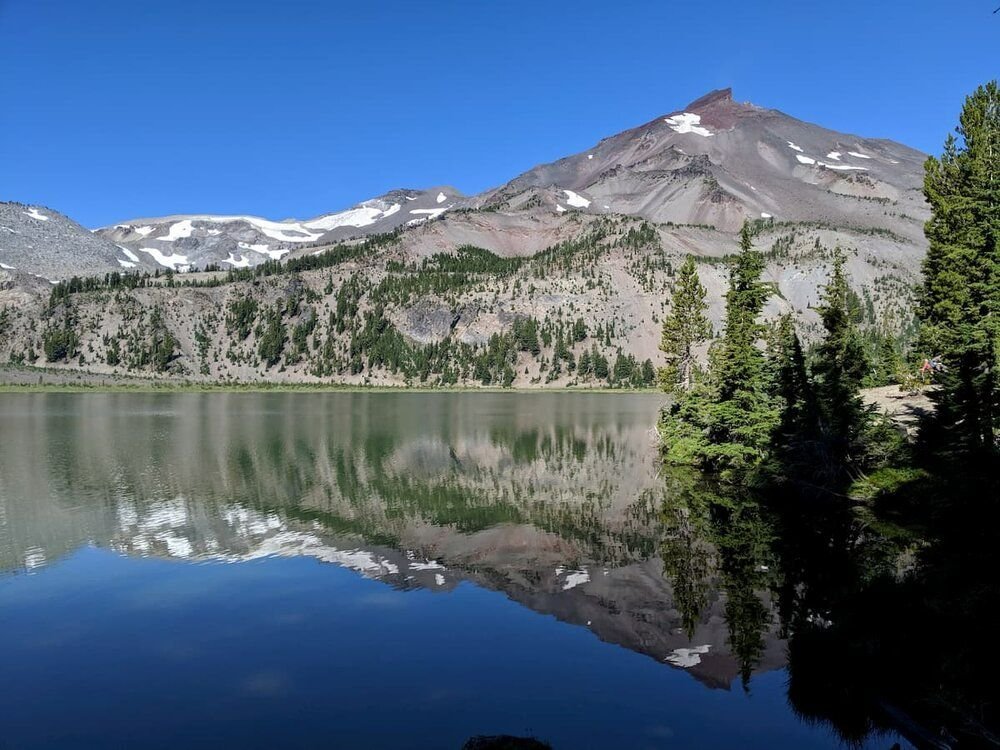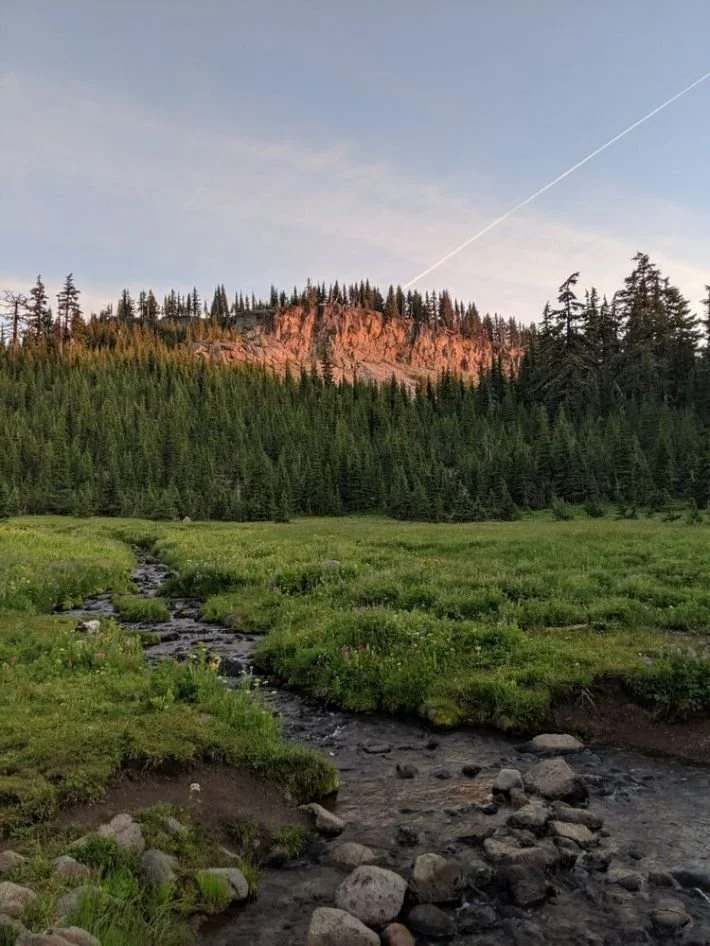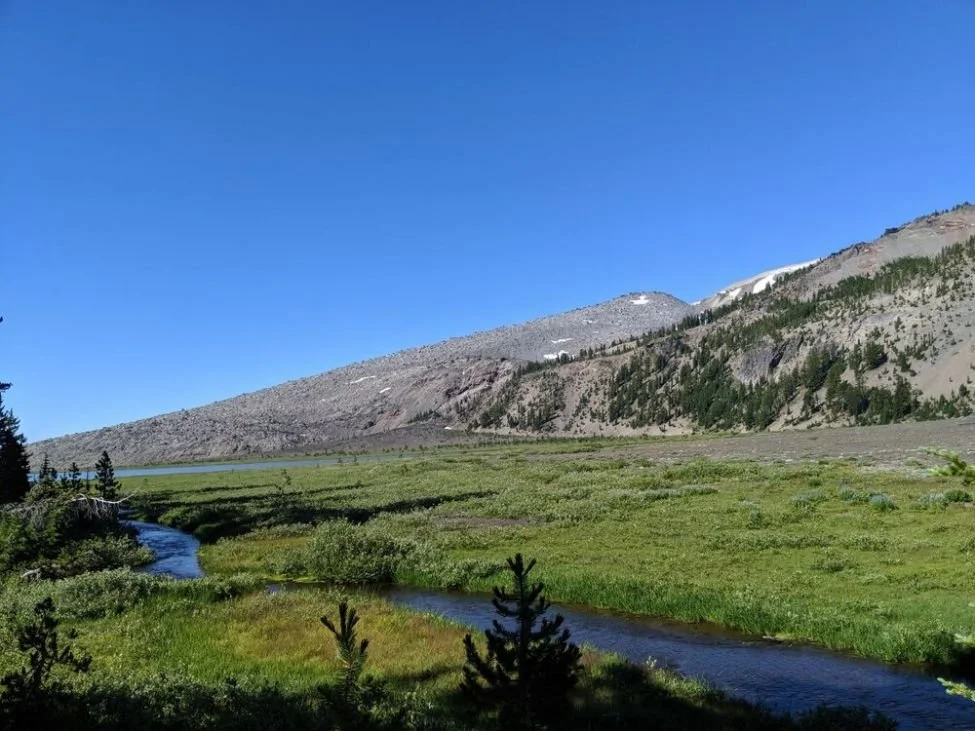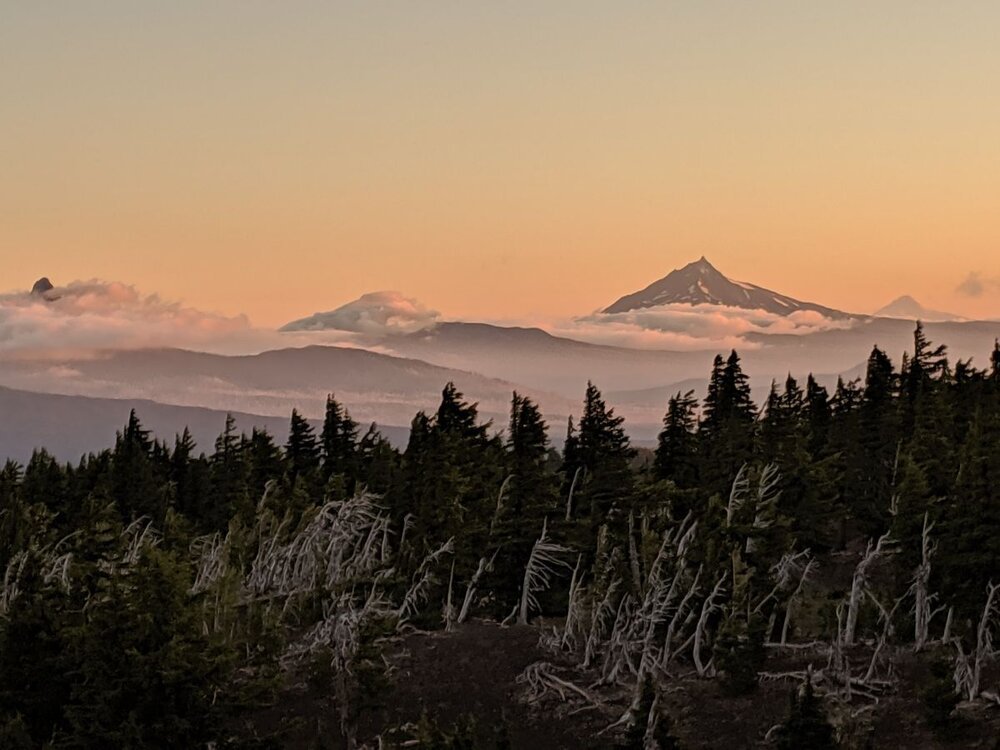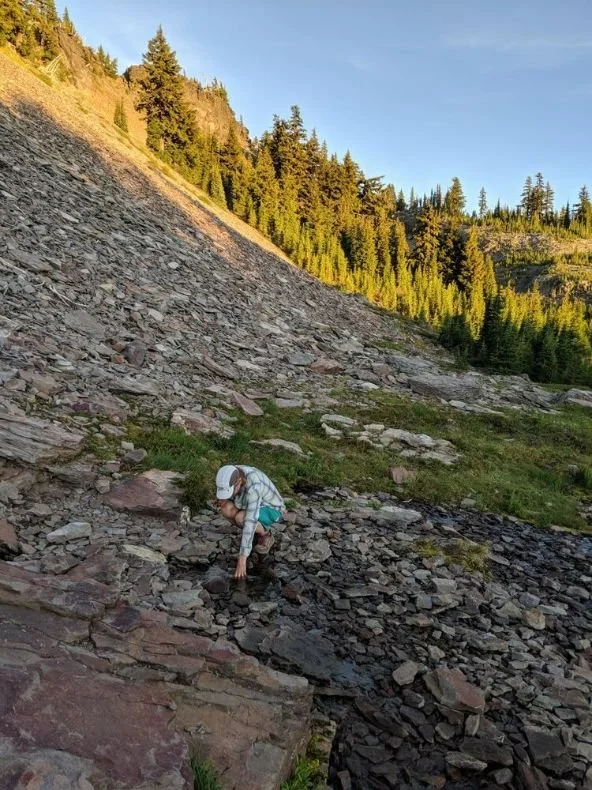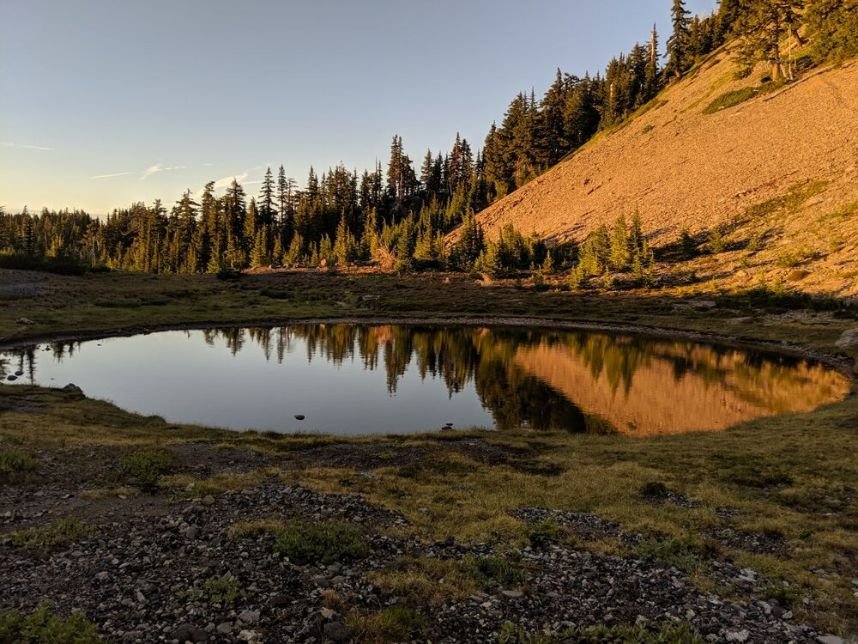Three Sisters Loop Backpacking Guide
Circumnavigate three volcanoes in Oregon through diverse Terrain
July 11th, 2023
The reflection of South Sister in Green Lake is a highlight of the Three Sisters Loop backpacking trip. Photo by Liz Thomas
Distance: 49.7 miles (starting at Lava Camp Lake Trailhead)
Days: 3 to 5 days
Elevation gain/loss: 7,000 feet
Best season: Summer
Advance Permits: Required
Difficulty: Moderate
One of the iconic backpacking trips in Oregon, the Three Sisters Loop circumnavigates three volcanoes all over 10,000’—South, Middle, and North Sister—and passes through diverse ecosystems, alpine lakes, a waterfall, wildflower meadows, a pristine wilderness area, ponderosa pine forests, and the remains of an old lava flow. It also passes through the 2012 Pole Creek Burn, which gives a fascinating glimpse of nature’s recovery process.
There are plenty of side trips to add on—including the walk up to the summit of South Sister. Middle Sister has some loose rock toward the summit, and certain routes require glacier travel. North Sister is a technical climb and should only be attempted by experienced mountaineers.
If you have time before or after your trip, don’t miss the historic Dee Wright Observatory, just down the road from the Lava Camp Lake Trailhead. It’s built from lava rock and has panoramic views including Mount Washington, Mount Jefferson, all three Sisters, and Mount Hood.
This hike has a special meaning for us at Treeline—we had our annual company retreat here in 2019, where ideas were hatched, and future goals were set!
We create reader-supported, objective, independently-selected gear reviews. This story may contain affiliate links, which help fund our website. When you click on the links to purchase gear, we may get a commission — without costing you an extra cent. Thank you for supporting our work and mission of outdoor coverage for every body! Learn more.
Hiking the Loop in July or August means you’re less likely to encounter snow. Photo by Liz Thomas.
Highlights
Alpine meadows and creeks lined with wildflowers
Unobstructed views of all three volcanoes
Pristine wilderness experience in the Three Sisters Wilderness
Beautiful ponderosa pine forests
Swimming in Green Lake, Moraine Lake, and other lakes on side trips
Hiking across the Wikiup Plain
Obsidian Falls
Well-graded and maintained hiking trail
Challenges
Can get crowded on summer weekends in the Green Lake area and South Sister
Permits are required and must be obtained weeks in advance via the recreation.gov
Timing required to avoid snow and mosquitos
Pole Creek Burn area
The lava fields are one of the most unique experiences on the Three Sisters Loop. Many hikers find the lava fields can be tough on feet, so be sure to wear sturdy shoes. Photo by Liz Thomas.
Best Season
Snow can be a significant obstacle to safely completing this loop, especially on parts of the Pacific Crest Trail. Aim to hike after the snow has melted—usually around mid-July.
August may have fewer mosquitoes and is usually a safe month for snow, though it will be warmer and more crowded.
September is ideal—fall colors, no bugs, and permits may be easier to get.
Difficulty and Skills
Navigation
Everything is on good hiking trail, and trail junctions are (mostly) well marked. However, if there is snow, the trail may be obscured. We recommend using maps and compass and a GPS phone mapping app like Gaia GPS. Be sure to preload the base maps for offline use in Gaia before you leave home.
elevation gain
The Three Sisters Loop's elevation gain total is 7,000 feet. Split over 3 to 4 days, this trip’s gain is manageable and the trail is well-graded.
Permits
Central Cascades Wilderness Permit
A Central Cascades Wilderness Permit is required for all overnight trips between June 15 and October 15 in the Three Sisters, Mt. Jefferson, and Mt. Washington wilderness areas. Approximately 40% of the permits will be released at 7 am PDT on the first Tuesday in April, and 60% will be available 7 days in advance of a trip. All permit reservations must be made on the recreation.gov website or app, or by calling 1-877-444-6777 or TDD 877-833-6777. You'll need to create an account with recreation.gov for an overnight permit. The Forest Service office does not issue permits.
You’ll need to provide your name, entry date, entry trailhead, group size, and length of trip (up to 14 consecutive days). Only one member of a group needs to register for a permit, and groups can include up to 12 people. An overnight permit costs $6 per group. Group members must start on the same day and camp together.
A Central Cascades Wilderness Permit is also required for day hikes at 19 of 79 trailheads in the Three Sisters, Mt. Jefferson, and Mt. Washington, wilderness areas and must be obtained at recreation.gov. Day use permits are released in 2 windows – 10 days before and 2 days before the trip date, and cost $1 per person (maximum group size of 12). You do not need to have an account with recreation.gov for a day use permit.
As of 2021, the Forest Service discontinued their old system: free permits that were self-issued at the trailhead.
Obsidian Limited Entry Area
Access via the Obsidian Limited Entry Area Trailhead requires advance permits. As of 2023, using the Obsidian Trail Limited Entry Area Trailhead to access the Three Sisters Loop is now part of the general Central Cascades Wilderness permit. For a day use permit for the Obsidian Trail, choose the Obsidian Trail as your entry trailhead when applying for a permit via this link at Recreation.gov.
FIRE CLOSURES
Wildfires can temporarily close trails and trailheads. To stay up to date on closures in Three Sisters Wilderness prior to your trip, check out the USDA Forest Service’s fire closure page.
Maps and Guidebooks
Gaia
We like the Gaia navigation phone app because it’s easy to use to check if we are on route.
Maps
We’re big fans of Green Trails Maps, which are easy to read and are printed on waterproof paper. We carried the Bend-Three Sisters Map 622SX. We also carried the National Geographic Trails Illustrated Bend / Three Sisters Map because—well, we love maps.
getting there
BY PLANE
Fly into Redmond, Oregon, which has a small regional airport: Redmond Municipal Airport (RDM) also known as Robert’s Field Airport. RDM is the airport that serves Bend, Oregon and is the next town over. There are flights available from Alaska Airlines, Delta, United, Avelo, and American Eagle. You can get direct flights from Portland, Seattle, Denver, San Francisco, Phoenix, Santa Rosa, Los Angeles, and San Diego. You can get flights from Palm Springs and Chicago (seasonally).
From RDM, there are several car rental options that can get you up to the trailhead. Otherwise, see the section below on bus and shuttle services from downtown Bend.
By Car
Directions to Lava Camp Lake Trailhead from Portland: take I-5 south to exit 253, toward Bend. Continue onto Highway 22 (Santiam Highway) for 80 miles. Slight left onto US-20 E and continue for 21 miles, driving past Black Butte Ranch. Turn right on NF-1012 and 2.9 miles later reach Highway 242 (McKenzie Highway). Turn right, west, and continue for 10 miles. Lava Camp Lake Trailhead will be on your left.
Bus and Shuttle Services
As of 2023, the Central Oregon Breeze offers daily bus service between Portland (Portland Airport and Amtrak Union Station) and Bend (River Plaza, Hawthorne Station, and Circle K) with 8 other stops in between.
From Bend’s Hawthorne Station, transfer to the Cascades East Transit Route 29 to Sisters.
From Sisters, you’ll need to hitchhike the 15 miles to the Lava Camp Lake Trailhead. As this area is frequented by PCT hikers, it’s a relatively easy hitch because locals are familiar and comfortable with giving rides to hikers. To see more about how to get around on the PCT, read our PCT Gear List and Strategy story.
Trailheads
The loop can be accessed from several trailhead parking lots. We started at the Lava Camp Lake Trailhead parking area because it is easy to access from a paved road (rather than a gravel forest road) and it’s the shortest trail distance to reach the loop. Access trailheads are as follows:
Lava Camp Lake Trailhead (NOT Lava Lake Campground)
Scott Pass Trail (1.3 miles one way)
Pole Creek Trailhead (1.4 miles one way, recreation pass required)
Park Meadow Trail (5.2 miles one way)
Green Lakes Trail (1.9 miles one way, recreation pass required)
Devils Lake Trail (2.3 miles one way, recreation pass required)
Scott Lake (5.0 miles one way)
Obsidian Limited Entry Trail (3.8 miles one way, advance permits required for day and overnight use)
Post-Trip Favorite Restaurant
Sisters, Oregon, has no shortage of fantastic restaurants. For breakfast and lunch, the Cottonwood Cafe should not be missed (garlic truffle fries, anyone?). We’re big fans of Angeline’s bakery, which has fresh baked goods and juice, kombucha, vegan, and gluten-free items. Tacos El Comal inside Space Age General Store is a great place for burritos. Open Wine Bar has an epic artsy patio with live music on weekends. Sisters Coffee is a good stop for a latte and some pastries. And for the local beer scene, Three Creeks Brewing has fantastic pizza and burgers.
Rules and regulations
Here’s a list of some of the regulations in the . Be sure to check what is written on your permit and talk to the ranger about conditions before you go.
Follow Leave No Trace Ethics including camping and pooping far from water.
Group size is limited to 12 people.
A Recreation Pass may be required, depending on the parking area.
A Wilderness Permit obtained in advance online is required from June 15 to October 15.
Camping is prohibited in the Pole Creek Burn area and the Obsidian Limited Entry Area.
Advance permits are required in the Obsidian Limited Entry Area if accessing the loop from the Obsidian Trailhead.
Dogs need to be on-leash in Three Sisters Wilderness on Green Lake, Moraine Lake, South Sister, Soda Creek, Todd Lake, and Crater Ditch Trails, from July 15 to September 15.
Campfires are prohibited in many high-use, sub-alpine, and alpine areas. Signs will be posted where fires are prohibited. Given how many wildfires have hit the Central Cascades and Oregon in the last few years, please don’t have a campfire.
Water Planning
Water is plentiful on this hike, even after the snow melts. You’ll pass many reliable creeks, springs, and lakes. Don’t miss Minnie Scott Spring, which is about 100’ east of the PCT, with its cold, clear spring water. Always know the distance to your next water source and plan accordingly.
Bears and Food Storage
There are no bear canister requirements for this trip. However, proper food storage is Principle 6 of Leave No Trace—Respect Wildlife. Consider storing your food in an OPsack or an Ursack AllMitey Bear and Critter Sack to keep rodents out of your food.
We like this article by REI to be useful in describing food storage techniques for camping in bear country.
SIDE TRIPS
Be sure to carry the right map and compass. We also found a GPS app pre-loaded with the Central Cascades area to be useful to have on our phones.
South Sister
At 10,358’, South Sister is the highest peak of the Three Sisters. It’s also the most accessible, with good trail to the top via the South Sister Climber Trail. Where the loop intersects with the Climber Trail near Moraine Lake, it’s 3.8 miles and 3,600’ to the top. Start early, wear sunscreen, a sun shirt, sun hat, and sunglasses because this trail is above treeline and very exposed. Avoid weekends when crowds can be overwhelming.
Camp Lake and Demaris Lake
Camp Lake is a short 4.8 miles off the Green Lakes Trail via the Camp Lake Trail, with only 1,200’ of elevation gain. South Sister is perfectly situated above the lake which makes for stunning views. Most campsites are exposed, so if conditions are windy you might want to consider Demaris Lake.
Demaris Lake is reached via the Demaris Lake Trail, a scant 0.7-mile side trail off the Camp Lake Trail (or 3.2 miles from the Green Lakes Trail). Unlike Camp Lake, most campsites are protected from the wind. Like Camp Lake, the views are stunning.
Chambers Lakes Basin
The Chambers Lake Basin can be reached via the Camp Lake Trail. The views are glorious, and snow can last well into July.
Sisters Mirror Lake
Sisters Mirror Lake is a 5.3-mile detour via the Devils Lake Trail. There are no mountain views, but if you love alpine meadows as we do, you won’t be disappointed. You can rejoin the loop trail a different way than you came via the Pacific Crest Trail and still enjoy the Wikiup Plain.
Eileen Lake and Husband Lake
Reached by a 5.2-mile horseshoe trail off the Pacific Crest Trail, Eileen and Husband Lakes are not to be missed. Middle Sister provides a spectacular backdrop for the lakes, with excellent camping opportunities.
Matthieu Lakes
You’ll actually shorten your hike by 0.3 miles by taking the North Matthieu Lake Trail. North and South Matthieu Lake are small but beautiful and camping is only allowed in designated sites.
Golden Lake
Golden Lake is an easy 0.5-mile hike on the Park Meadow Trail. It's well worth it—with fantastic views of Broken Top framing the lake.
trip Variations
Do the Loop Counter Clockwise
We describe the hike in the Trip Summary as hiked clockwise (the direction we went), but counter-clockwise is an option, too. One perk of going clockwise as we did is that you get through the Pole Creek Burn area at the beginning. Since camping is prohibited in the burn area (approximately six miles), it’s easier to time it at the start so that you don’t get stuck in the dark considering an illegal campsite.
Shorter Version via the Scott Pass Trail
You can cut off 4.6 miles by starting and finishing on the Scott Pass Trail. The Scott Pass Trail cuts east-west further south on the loop. However, you’ll miss the opportunity to see Matthieu Lakes.
Longer Version as a Figure 8
Using the Camp Lake Trail, you can cut between the Middle Sister and South Sister, twice, and create a figure 8 loop.
The spring above Obsidian Falls is one of the best water sources on the entire PCT—and just happens to be on the Three Sisters Loop. Photo by Liz Thomas.
Gear List
This is a list of what we carried. For more backpacking gear recommendations, see our Backpacking Gear section and our Essential Backpacking Accessories story. If you’re headed to the high country in the early spring or late fall, see our Shoulder Season Backpacking Gear article.
BACKPACK
We used the Gossamer Gear Gorilla 50 and Katabatic Gear Onni 55 (no longer in production) backpacks on this trek. They're both lightweight and comfortable with the Gorilla being able to fit a bear can and the tent without an issue. The Gorilla is a smaller version of the Mariposa, our Overall Winner in our Best Backpacking Backpack story. The Onni was our previous upgrade winner.
TENT OR TARP
We used the Six Moon Designs Haven and Haven NetTent on this trip. We love that the tarp and NetTent combine to make a double-walled tent that’s only 34 ounces. See our Best Backpacking Tents guide for more recommendations.
SLEEPING BAG
We both used the Katabatic Gear Palisade 30F quilt on this backpacking trip. A tried and true quilt that’s extremely warm for its weight, the Palisade is a favorite among long-distance hikers. See our Best Backpacking Sleeping Bags for more recommendations.
SLEEPING PAD
We used the Therm-a-Rest Neo Air XLite and Sea to Summit Ultralight Insulated Air on this trip. They’re both lightweight, comfortable, and easy to inflate without taking much volume in our pack (although the XLite is significantly lighter than the Sea to Summit). The Neo Air XLite is our Overall Winner in our Best Backpacking Sleeping Pads story. The Sea to Summit is a better option for side sleepers and is our winner for Best for Side Sleepers.
TREKKING POLES
We carried the Leki Jannu (now discontinued) trekking poles. The Jannus are a lightweight women’s trekking pole but are sturdy enough to take a lot of pressure. Read our Best Trekking poles story for our top picks.
BACKPACKING STOVE
We used the Soto MicroRegulator stove and the MSR Pocket Rocket on this hike. It’s only 2.6 ounces and works in the wind better than just about any other stove we’ve used. Read about all of our top picks in our Best Backpacking Stoves story.
POT AND SPOON
We both also used our TOAKS 750 L titanium pot and TOAKS long-handled spoon. This lightweight and affordable pot is our Overall Winner in our Best Backpacking Cook Pot story and the spoon is in our Backpacking Essentials story. We like both of them so much that they’re also in our gift guides. It’s amazing how such small things can make such a big difference on a backpacking trip!
WATER FILTER AND STORAGE
We used the Sawyer Squeeze as a gravity filter and the lightweight Sawyer Micro Squeeze as an inline filter on this trip. They’re both lightweight and fast. As an inline filter working with our Platypus Hoser, the Micro Squeeze gives us on-demand filtered water. We like that there’s no pumping required and no chemicals involved.
The Squeeze is the overall winner in our Best Backpacking Filters story.
HEADLAMP
We carried the BioLite 330 and Black Diamond Spot on this trip. Both headlamps are bright, lightweight, and have long battery lives. Both are top Overall Picks in our Best Headlamps story.
FOOD STORAGE
While bear cans aren’t required in Three Sisters Wilderness, it’s important to store food safely away from bears, marmots, and whatever other wildlife may be interested in your food. We used the LokSak OpSak odor proof bags to store our food. We found this article useful on smart food storage techniques for areas that don’t require bear cansiters.
Satellite Messenger
We carried a Garmin inReach Mini, which allows two-way texting from the backcountry, spot forecasting and more. It’s the Overall Winner in our Best Satellite Messengers and Personal Locator beacons story because of its light weight, ease of use, and reliability.
Maps and Compass
We wouldn’t go on a backpacking trip without our trusty Suunto M-3 D Leader compass and maps.
First Aid Kit
Homemade. See our Make Your Own Emergency Kit story.
Rain Jacket
We carried the Montbell Versalite and Outdoor Research Helium (men’s and women’s) rain jackets. The Helium is an ultralight winner in our Best Light Rain Jackets guide. See that story for more recommendations on rain jackets for backpacking.
Down Jacket
For insulation, we carried the Patagonia Micro Puff (men’s and women’s). You can read our in-depth long-term review of the Micropuff. It’s lightweight, compact, and warm—perfect for summer and early fall backpacking. Both are winners in our Best Synthetic Jackets story. If you prefer down jackets, see our Best Down Jackets guide.
Hiking Underwear
Our go-to favorites—Patagonia Active Briefs and Smartwool Merino 150 bikini underwear. Both dry quickly and stay in place—two essentials for hiking. They are featured in the Urban Hiking Packing List.
Warm hat
At 0.8 ounces, the Montbell Chameece inner cap has the perfect amount of warmth for a summer trip. It’s also a favorite in our Arizona Trail Gear List.
Gloves/Mittens
We carried the Montbell Windstopper Trekking Mittens and PossumDown Gloves. Note that the PossumDown gloves are fairly delicate—using them with trekking poles is not a great idea. But they’re incredibly soft, warm, and lightweight for use in camp.
WHAT TO WEAR
Below is what we wore on the Three Sisters Loop. Here are our favorite things to wear while backpacking and hiking from our Hiking Apparel page. If you’re headed out in early spring or late fall, check out our Shoulder Season Hiking Gear guide.
HIKING SHOES
We wore the Altra Lone Peaks (men’s and women’s) and Altra Olympus (men’s and women’s) on this trip. The trail was well-maintained and had no snow, so we felt comfortable wearing these lightweight trail runners on this kind of terrain. The Lone Peaks, are our Long Distance Winners in our Best Women’s Trail Running Shoes guide and Best Men’s Trail Running Shoes guide.
We definitely saw a lot of backpackers in boots for this trip, especially around the rocky Old Army Pass. If you’d feel more comfortable in boots, check out our Best Hiking Boots story or our Best Lightweight Hiking Boots story.
A nice footwear compromise for this trip would’ve been hiking shoes, which are designed to feel like a trail runner but have stability more like a boot. See our Best Hiking Shoes story for footwear that has more durability and stability than trail runners.
Hiking Shirts
We wore the Patagonia women’s Sun Stretch shirt. Because much of the route is exposed, having adequate sun protection was essential. Both are in our Best Sun Shirts story.
Hiking Socks
Each of us carried 2-3 Pair socks. The men’s and women’s Darn Tough Hiker Quarter Crew socks are soft, durable, comfortable, and fit like a glove. See our Best Hiking Socks article for more about why we love these socks.
Hiking Skirt
Both of us wore our favorite hiking skirt—the Purple Rain Adventure Skirt. Both excel at feeling comfortable, not too hot, and nice and stretchy for lots of mobility. We like this skirt so much it’s also in our PCT Gear List & Strategy.
Sun hat
Sunday Afternoons Ultralight Adventure Hat and a trucker hat (augmented with the hood on our sunshirt). It’s lightweight and provides good coverage while also being windproof. It’s a favorite in our Long Term Arizona Trail Gear List.
Why you should trust us
Naomi Hudetz is long-time Oregon resident, thru-hiker and co-founder of Treeline Review. She brings decades of private sector experience in project management, budget and pricing projection, and long-term business vision, strategy, and goals. She’s hiked extensively in the Central Cascades, including during a thru-hike of the Pacific Crest Trail. She’s thru-hiked the Three Sisters Loop several times, including as part of a “corporate retreat” for Treeline Review.
She received the Triple Crown award for hiking for completing the Appalachian Trail, Pacific Crest, and Continental Divide Trail and has hiked numerous other distance routes, including the Great Divide Trail across the Canadian Rockies (twice), Grand Enchantment Trail, Pacific Northwest Trail, the Arizona Trail, (most of) the Idaho Centennial Trail, the first known thru-hike of the Blue Mountains Trail, and the Oregon Desert Trail.
She is the former Treasurer of the American Long Distance Hiking Association-West and is based in White Salmon, Washington.
You can read Naomi’s Treeline Review stories on her author page.

